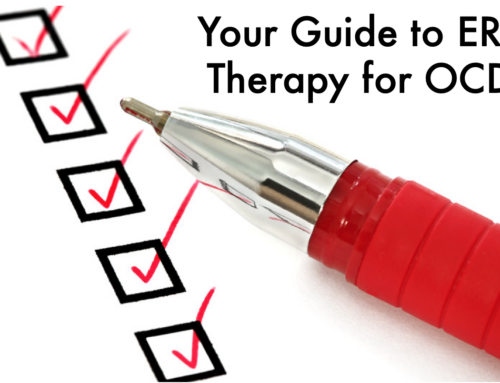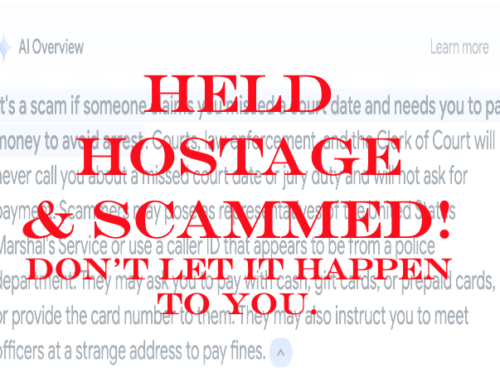Today I’d like to tell you about the most powerful method I’ve found to effectively deal with OCD. To explain it, let me share a quick metaphor.
The Man in the Park
Let’s say that you’re walking through a park. As you’re taking in the fine spring day, you notice a man in a grassy area to your left shouting. As your walk takes you closer to him, you realize that he seems to yelling about the end of the world, and how it’s going to happen tomorrow. You see as you get even closer that he has a stack of pamphlets, and he’s trying to shove them into the hands of unsuspecting passersby. You immediately veer away from him, not wanting to make eye contact with the end of the world spokesperson, in case he decides to try to shove a pamphlet at you. You leave the park, the doomsayer’s voice fading in the distance, and go on with your day, almost immediately forgetting that you even saw the person shouting about that tomorrow is supposedly the very last day for earth.
You’ve probably seen someone enthusiastically shouting about the end of the world in a public park or on a street corner or in a city square. And even if you spiritually or philosophically agree with some of what he’s saying, you try your best not to act interested or take a pamphlet, in case he were to direct some of his fiery tirade at you. You certainty don’t run home, grab your family together and say, “This is it! Tomorrow is the end! We have to gather everyone we love together so we can see them one more time before it’s all over!”
Why don’t you heed the crier’s warning? Because you don’t believe that tomorrow is the end of the world. You act as though what he is saying is completely irrelevant in your life, because it is.
This metaphor is one I use all the time with clients to explain how to most effectively handle OCD. Because OCD is the guy screaming about the end of the world in a park. And when you pay attention to OCD by doing mental or physical rituals, you are making eye contact or taking a pamphlet. Then OCD directs even more of its frightening monologue at you, because you’ve shown interest. You’ve acted like what it is saying is important, so you’d given it power and incentive to keep yelling.
But you have a choice about how you react. You could instead do exactly what you would do if you saw a guy yelling in the park: keep going, not acting as if what he is saying has any relevance for you. The guy in the park wants you to be frightened, worried, and take some sort of action because the end of the world is nigh. But you could choose to do the opposite of that: put your shoulders back (and doing so will actually make you feel more confident, as an added bonus) and confidently go on with your day. That’s why I call this technique Shoulders Back. It basically means that you hear what OCD is saying, but just like with the man yelling in the park, hearing it doesn’t change how you act. It’s just there and you go on with your day.
Shoulders Back is the most powerful strategy I’ve found to address intrusive thoughts, because it completely takes the wind out of OCD’s sails. It takes practice to master, and even then, you won’t always do it perfectly (which is good, since imperfection actually supports your recovery). But if you can become proficient at Shoulders Back, it can dramatically strengthen your recovery.
How to not make eye contact nor take a pamphlet
So how do you do keep walking and not make eye contact or take a pamphlet? I’ve found that it’s a matter of training your brain to pay attention to the present moment.
For instance, say my OCD tells me as I’m having dinner that I’ve offended my fried Kimberley with something I said. My OCD would then like me to start engaging with that content in my head, replaying the conversation, checking my memory of what Kimberley’s reaction was, rationalizing with myself about how what I said wasn’t meant to be offensive and surely she knew that, etc. But all that is not reality, not the present moment. What’s real is what’s in front of me: my dinner. So the moment I hear, “What if you offended Kimberley when you said that?” I… 1) put my shoulders back because that’s a physical action that conveys confidence to my body and brain (see “The Best TED Talks for People with OCD, Part 2” for how this works), which is the opposite of how OCD wants me to act and 2) choose to turn my attention to what I’m doing, which is eating dinner, without doing any compulsions.
I can use my five senses to help me pay attention to what matters in that moment: the smells of the food, how it tastes as I chew, how it feels to sit in the chair at the table, how cute my dog, Bella, looks as she’s begging for a taste of what I’m having, the ambient sounds of the house. Those things are actually in the present moment, and I’m directing my attention to them so that I do not engage with OCD in my head. Paying attention to what I was doing when OCD so rudely interrupted me is the equivalent of continuing to walk on by the man yelling in the park, acting as if what he’s saying isn’t relevant.
Now, what OCD is saying may feel relevant, and that’s OK. That’s just anxiety, and I can handle that. In fact, I welcome being anxious because that gives me practice beating OCD. But even though I’m anxious, I keep my attention trained on what I’m doing, eating my dinner. I do not in any way address what OCD is saying or have a conversation with it in my head or do any physical rituals. I am laser focused on what matters to me, which is eating dinner.
If I do not engage with the OCD, the OCD becomes quiet. Because I didn’t do a compulsion, I haven’t given it anything to work with, and most times, it just gives up, and I quickly forget about what it was worried about. And then something even better happens: the more that I practice Shoulders Back, the less OCD bothers me. It’s almost as if it begins to realize, “When I bother Shala, she doesn’t do anything to address my worries. So what’s the point of even bringing this stuff up?”
When you end up with a pamphlet
Sometimes, however, OCD is sneaky, and all of sudden I look down and realize it has stuffed a pamphlet into my hands. By this I mean that somehow I’ve engaged with its content by doing a mental or physical ritual. For instance, I might have accidentally argued with it in my head, “Kimberley wouldn’t be offended by that!” or I might have done a quick mental scan of how she looked when I said whatever it is OCD is worried about. And unfortunately, that’s all it takes. As soon as I have any sort of conversation with or reaction to OCD that validates its content, it knows it’s got me: “Yes, she responded! She thinks this matters!! Woo hoo!!!”
If I can course-correct quickly enough by putting my shoulders back and re-engaging with the task in front of me, I can sometimes recover from my mistake of engaging with OCD, and it will leave me alone. But many times, if I’ve had any sort of conversation with it or if I’ve done any sort of physical compulsion, it will continue to bother me. If we think about the man in the park metaphor, this makes sense. Most people ignore the guy in the park. If someone stops to listen, makes eye contact with him, and/or takes a pamphlet, he’s going to think, “Wow! A live one! No one is ever interested in what I’m saying, but this person is, so I’m going to really focus on convincing him. If he leaves, I might just follow him, because he’s shown some interest, and if I just keep giving him all the reasons the world is ending, he’ll be convinced, too! I’m not going to let him get away!”
OCD is a lot like that. If you show interest in what it says by doing mental or physical compulsions, it knows that this particular intrusive thought has potential. So it’s not going to give up easily. It’s going to keep running along beside you as you try to leave the park, hurling more intrusive thoughts your way, hoping you’ll take the bait and do some more rituals.
If this happens, and you find the OCD won’t leave you alone, the most important thing is to stop doing rituals. If you’re a mental ritualizer and you cannot direct your attention back to what you were doing because you’re now hooked in OCD’s content, this is when I use “may or may not” statements.
I will describe these more fully in a subsequent blog post, but in essence what I do is say “I may or may not have offended Kimberley” out loud over and over so that I cannot do mental rituals in my head and so I can be present with my obsession in a way that’s therapeutic (i.e. letting it be there without engaging with the thought compulsively in my head). In other words, if OCD is running along beside me like the man in the park, what if’ing me to death, unwilling to let me escape because I showed interest, that is what becomes the reality of my present moment. At this point I can’t do Shoulders Back easily because I’ve acted like what OCD said was important, which is the opposite of Shoulders Back. That made OCD get bigger and louder, and I want to be present with those loud thoughts in a way that shows my mind I can handle them without compulsively engaging with them. So this is when I’d use a “may or may not script.”
The difference between scripting and compulsively talking with OCD in your head is as follows:
- Compulsive interaction with OCD in my head: “Kimberley wouldn’t be offended. She wouldn’t be mad at me. She knows I didn’t mean anything by what I said. I think this will all be fine. In fact, I should text her just to make sure she doesn’t seem mad at me” [now I’m finding excuses to do more rituals, this time ones that are physical]….
- Therapeutic use of “May or may not (MOMN)”, said out loud to drown out any tendencies to talk with OCD in my head: “Kimberley MOMN be offended. She MOMN be mad at me. I’m accepting this uncertainty. I don’t have any control over her or anyone’s reactions to what I say, and she MOMN be offended. I’m not going to do anything to check with her about this. I can handle being anxious and I want to be anxious, because that’s how I continue to make my life my own, OCD.”
I will say these MOMN statements out loud for a short time, and once I feel that I’ve better accepted the uncertainty of the situation, I once again try Shoulders Back, going back to acting as if what OCD says doesn’t matter. If I’m still getting bombarded with intrusive thoughts, I’ll go back to MOMN and then try Shoulders Back again and continue repeating this cycle until OCD quiets down.
Having to use the MOMN statements is a lot of work, so I do the best I can to do Shoulders Back immediately any time I have an intrusive thought, directly my attention back to what I was doing and going on with my life.
Shoulders Back is not thought stopping
There is an old CBT technique called “thought stopping” that was used for OCD decades ago. The technique is that every time you have a “bad thought” you flip yourself with a rubber band and/or say “stop!” to stop the thought. The 2019 Spring issue of the IOCDF newsletter explains why this technique doesn’t work and how it can even make OCD worse, because suppressing thoughts can lead to ironic rebound, where you have even more of the intrusive thoughts after trying to repress them.
What I do with Shoulders Back is not thought stopping. The intrusive thought is welcome to be in my head, but I’m not going to compulsively engage with it. As I wrote about in my blog post “Why There’s No Cure for OCD“, OCD is not the presence of intrusive thoughts—it is, instead, the reaction to the intrusive thoughts, whether that reaction be physical or mental. What I am choosing to do with Shoulders Back is to not react compulsively either physically or in my head to my intrusive thoughts. I am stopping the conversation I could have with OCD in my head about its content. I’m stopping my compulsive reaction, not the intrusive thought. What tends to happen, however, when I don’t interact with the intrusive thought compulsively is that the intrusive thought goes away. But if I try to push the intrusive “what if?” thoughts away, that’s telling the OCD that they are too painful for me to deal with, that I am taking them seriously, and that will cause the intrusive thoughts to increase.
Shoulders Back is the most powerful tool in my arsenal because it is the essence of exposure therapy: acting as though OCD’s content is irrelevant. Let your actions show that you are giving your attention to what matters to you in your life, not to your OCD’s worries.
Ep. 36 of Your Anxiety Toolkit: This EASY tool Might Change Your Way of Coping with Anxiety (W/ Shala Nicely)
You can listen to me discuss the Shoulders Back! concept with Kimberley Quinlan, LMFT on one of the earliest episodes of the Your Anxiety Toolkit podcast below.
 Shoulders Back: Man in the Park Q&A
Shoulders Back: Man in the Park Q&A
I’ve written an Q&A about Shoulders Back based on questions from readers. You can also see my book, Is Fred in the Refrigerator? Taming OCD and Reclaiming My Life, for more about how I use Shoulders Back in day-to-day life.
If you’d like to receive notifications of new blog posts, sign up for my Shoulders Back! newsletter, and I’ll send you OCD-taming tips & resources every month.
My blogs are not a replacement for therapy, and I encourage all readers to find a competent ERP therapist. See the IOCDF treatment provider database for a provider near you.










[…] Stuart’s show notes can be found at The OCD Stories website. Find all the other of Stuart’s podcasts with therapist Shala Nicely here. I also like Shala Nicely’s suggestion for those with OCD … Shoulders Back! The Man in the Park […]
[…] in the front row because it’s a challenge to dance alongside such talented people. I put my shoulders back and act as though all the noise in my head about how I can’t dance is […]
[…] intrusive thoughts and the resulting anxiety barge in, you can do your best to put your shoulders back and say, “I expected you to be here, OCD, and I’m glad you are, because I’ve been wanting to […]
[…] lot stronger and braver than you are, OCD, as evidenced by the fact that even now I can put my Shoulders Back and act like what you’re saying is […]
Shala,
After reading this I wondered- are the intrusive thoughts (everybody gets them) considered ocd thoughts? If not at what point in the Man in the Park metaphor are they ocd thoughts? Once you begin to compulse? Second, with the man in the park- we have to decide if the thought we had is real and needs action- signal or if it’s just the man yelling in the park intrusive thoughts (which are ocd thoughts) correct? Third, what are some red flags that the thoughts are ocd thoughts and not real concerns that we need to take actual action on?
Thanks you!
Hi Sarah, please see my blog post https://www.psychologytoday.com/us/blog/beyond-the-doubt/201804/why-there-s-no-cure-ocd for my explanation of why there are actually no OCD thoughts…just intrusive thoughts that OCD reacts to. Part of having OCD is not knowing whether the thoughts need to be addressed or whether they are intrusive and just “noise,” and trying to determine whether thoughts are “real” or not can become part of the obsessive-compulsive cycle. But if you’d like more info on signals vs. noise, please see Reid Wilson’s book Stopping the Noise in Your Head https://www.amazon.com/Stopping-Noise-Your-Head-Overcome-ebook/dp/B0158NDNOS.